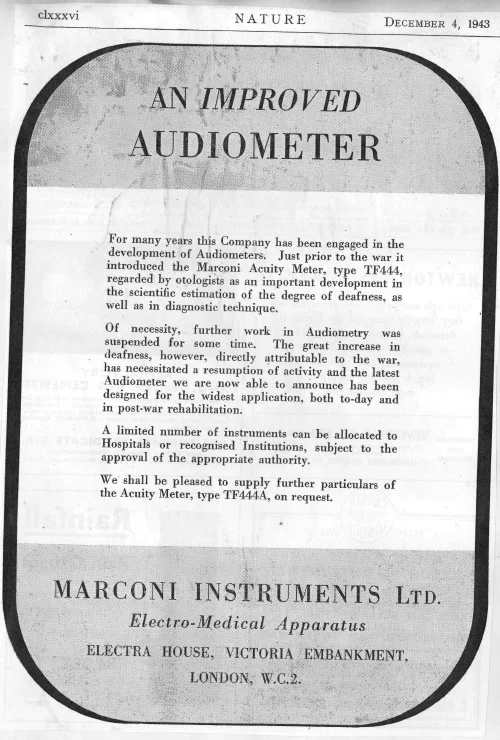The Marconi M.M.E.5 Audiometer & TF444A & TF895 Acuity Meter
by Nigel Adams
In our first blog we covered the background history of Marconi Instruments and how the company came into being. This time we begin our journey through the various pieces of instrumentation aimed at the field of medical science.
Some of the initial work into the medical electronics sector was undertaken before WW2, when the company was still known as Marconi – Ekco Instruments. It was known as the ‘Audiometer’ and produced for use in hospitals or larger doctors’ practices/institutions (probably prior to the establishment of the modern ‘clinic’ as we know it now).
Initially this unit was marketed as the M.M.E 5 (Marconi Medical Equipment), it was a cream painted rectangular metal casing approximately the size of a large shoebox, with a top mounted carry handle and suited for AC and DC Mains operation. Remembering this was before the national grid was established and a number of locations away from towns had DC mains supplies – possibly generated locally or even on-site, using a stationary engine as a power plant to drive a generator.
The unit contained a headset to be worn by the patient, a patient signalling switch and a handheld microphone used by the Otologist conducting the test. A ’normal’ range of audible hearing is regarded as being from below 20Hz (Hertz, formerly cycles per second) up to around 20KHz (20,000 Hertz) for a typical person – of course it is known that most peoples’ hearing capability decreases as we age. So this unit would cover the range suitable for children as well as adults.
In operation, the Audiologist (Otologist) would set up the equipment such that the patient placed the headset over one ear and the sound level adjusted so that the user could hear a tone. The frequency and levels were then adjusted over the range of the test and the patient could indicate when they were no longer able to hear the tone by pressing the signalling switch. The Otologist would then record the results and form a diagnosis. The process would then be repeated for the patient’s other ear. For patients with profoundly hard of hearing there was a bone conduction unit, and a Masking unit (for additional tuning) was offered as optional accessories.
It was clear that this type of examination became much more important during and after WW2 due to the debilitating effects of loud explosions and gunfire etc. that the armed services and general public would experience during those years. Hearing loss/damage and acute deafness became a major issue in these post war years.
The first recorded use of this equipment is shown in a company advertisement for a demonstration stand in 1937 at the Physical Society Exhibition (Stand 16).
During the war years Marconi Instruments name succeeded the Ekco branding and the later model of Acuity Meter replaced the MME5 , becoming the TF444 and TF444A. An advertisement for this appeared in the December 1943 issue of ‘Nature’ magazine – costing the princely sum of £12-0-0d (for placement of the advert!).
Interestingly, mention is made of ‘subject to approval of the appropriate authority’ in the text. Such items being restricted in their use to certain facilities (wartime restrictions still being in force).
The later TF444 /TF444A and subsequent TF895 models were similar in operational principle to their earlier counterparts, although there were new features and a restyled casing. This equipment marked one of the first aids to modern diagnosis and treatment of debilitating hearing conditions that benefitted the wider public.
For further reading about Marconi’s early life and his business developments, please see other reference material in the archive at George Marshall Medical Museum.


